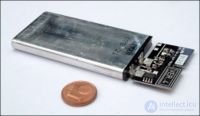Lecture

Lithium-polymer battery (more correctly lithium-ion polymer battery (lithium-ion polymer battery), there are different abbreviations: Li-pol , Li-polymer LiPo , LIP , Li-poly , etc.) - this is an improved design of lithium ion battery A polymeric material with inclusions of a gel-like lithium-conducting [ refined ] filler is used as the electrolyte. [1] Used in mobile phones, digital technology, radio-controlled models, etc.
Ordinary household lithium-polymer batteries are not capable of delivering a high current, but there are special power lithium-polymer batteries capable of delivering a current that is 10 or even 130 [2] times the numerical value of the capacity in ampere hours. They are widely used as batteries for radio-controlled models, as well as in portable power tools and in some modern electric vehicles.
Batteries are fire hazardous when overcharging and / or overheating. To combat this phenomenon, all household batteries are equipped with an integrated electronic circuit that prevents overcharging and overheating due to excessive charge. For the same reason, they require special charging algorithms (chargers).
The number of operating cycles is 800–900, with discharge currents in 2C until capacity loss is 20% (for comparison: NiCd - 1000 cycles, NiMH - 500, LSD NiMH - 1500, LiFePO4 - 2000). Generally speaking, any data on the number of working cycles is still very small and their characteristics should be treated critically in this case [the source is not indicated 285 days ] . In addition, the technology of their manufacture is being improved, and it is possible that at the moment the figures for this type of battery are different.
Under the influence of a charge, lithium-polymer and lithium-ion batteries reduce their capacity depending on the temperature conditions.
Deep discharge completely disables the lithium-polymer battery. Optimum storage conditions for Li-pol batteries are achieved with a 40% charge on the battery capacity. Lithium batteries age, even if not used. After 2 years, the battery loses about 20% of its capacity [3] . Accordingly, there is no need to buy a battery “in reserve” or overly indulge in “saving” its resource. When buying, be sure to look at the production date to know how much this power source has already been in stock. If more than two years have passed since the date of manufacture, it is better to refrain from purchasing.
Comments
To leave a comment
Power supplies for electronic equipment
Terms: Power supplies for electronic equipment